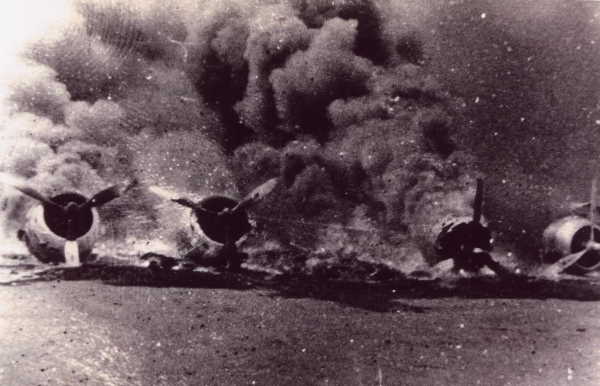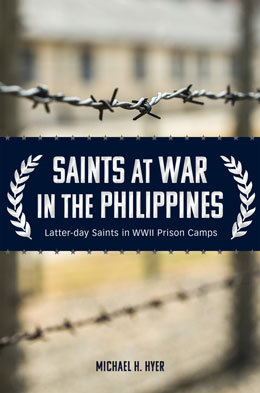Everything Changes
Jesus, Savior, pilot me
Over life’s tempestuous sea;
Unknown waves before me roll,
Hiding rock and treach’rous shoal.
—Edward Hopper, “Jesus, Savior, Pilot Me”
On December 7, 1941, the Japanese bombed Pearl Harbor. The attack was swift and brutal. Three hours after the first bomb was dropped, more than two thousand people were dead, and eight battleships and more than 180 planes were destroyed. The attack also cut off supply lines to the Philippines. Across the international date line in the Philippines, it was December 8, and with the news of the attack on Pearl Harbor, the chaos of war soon came to the Philippines.
In response to the Pearl Harbor attack, US military leaders first ordered a bombing attack from the Philippines on Japanese forces in Taiwan (Formosa). B-17 bombers and P-40 pursuit fighters took to the air from Clark Field. But the attack was delayed, then canceled, then approved again. Consequently, planes that had taken off were left circling over Clark Field while commanders debated what to do. With the bombing run to Taiwan back on, they had to land to refuel. In a case of truly unfortunate timing, Japanese bombers appeared over Clark Field just after the planes had landed; behind the bombers were the fighter planes, the infamous Japanese Zeros.[1]
 A B-17 bombed by Japanese in the attack on Clark Field, December 8, 1941. The BenHaven Archives. Courtesy of G. A. von Peterffy.
A B-17 bombed by Japanese in the attack on Clark Field, December 8, 1941. The BenHaven Archives. Courtesy of G. A. von Peterffy.
The 200th went into action, frantically firing their antiaircraft guns at the Japanese bombers, but their efforts were largely futile. The 200th had not yet been able to set up all their equipment, and much of what they had was defective or outmoded. The ammunition was WWI surplus, manufactured in 1918, and most shells were duds. The fuses on the antiaircraft shells were badly corroded, and only about one in six actually exploded. Those shells that exploded had fuses that were effective only to about twenty thousand feet, a problem the Japanese bombers avoided by flying at twenty-three thousand feet. With their 37-millimeter guns and .50-caliber machine guns, however, the 200th had a chance at the low-flying Zeros. Even though this was the first time they had actually fired the guns with live ammunition, and despite the fact that only about one in six of the old WWI-era shells actually fired, they managed to down five Japanese aircraft.[2] The 200th earned the distinction of being the first US unit to fire shots during World War II.[3]
The soldiers of the 200th fought valiantly, and acts of heroism were common. Ground and combat crews manned guns of grounded aircraft, and men dashed into flaming buildings to rescue comrades as well as supplies and equipment. Others braved strafing gunfire to help the wounded. However, the attack was clearly a rout by the Japanese. Japan had largely destroyed America’s air force in the Philippines on the ground.[4]
Manila and the 515th
Realizing that Manila had no antiaircraft protection, commanders in the 200th hastily sent thirty officers and five hundred enlisted men that night—December 8—to Manila to set up an antiaircraft defense. This group would later be formally designated as a separate unit, the 515th Coast Artillery, under the command of Colonel Harry M. Peck, the executive officer of the 200th.[5] While Hamblin and Baclawski remained with the 200th, Brown and Keeler were assigned to the new 515th and deployed to Manila that night with Colonel Peck as commander.[6]
Guns were uncrated, assembled, dug in, and, quite remarkably, ready to shoot in twenty-four hours. About 650 officers and enlisted men from the Philippine Army were hastily recruited, trained, and added to the group. On the morning of December 10, Japanese bombers attacked Manila, including the important Cavite Naval Yard, but this time they met a pattern of antiaircraft fire. The puffs from the antiaircraft guns, however, were again more spectacular than effective, as the Japanese bombers were again flying above the height at which the US antiaircraft shells were set to detonate.[7]
War Plan Orange Revisited—Retreat to Bataan
In the event of a Japanese attack, War Plan Orange called for the Americans to abandon Manila and cross over to the Bataan Peninsula, located on the west side of Manila Bay. The US would retreat from Manila without defending it, leaving it an “open city” and hopefully sparing the civilian population. Surrounded on three sides by water and protected somewhat to the north by mountains, the Bataan peninsula was an ideal place for such a retreat. From Bataan and the island fortress Corregidor, the Americans could still deny the Japanese the use of Manila Bay and its deep-water harbor and could hold out until rescue or reinforcements arrived by sea. Manila Bay was the main prize in the Philippines, and its control was essential to securing the strategic value of the Philippines.[8]
A couple of weeks after the initial attack, the Japanese landed on the island of Luzon, and their air attacks on Clark Field and the Manila area intensified. On Christmas Day, December 25, General MacArthur implemented War Plan Orange.[9] The key to the success of War Plan Orange was a retreat from Manila to the Bataan Peninsula, and the key to a successful retreat lay in the cluster of bridges across the Pampanga River near Calumpit and the bridge over the Culo River at the critical Layac Junction. These bridges connected the roads leading west out of Manila and into the Bataan Peninsula. At Calumpit, the north and south roads met and turned west toward Bataan. Layac Junction was the gateway to Bataan. If those bridges remained intact, the forces could pass safely to the Bataan Peninsula, as the Japanese in the south and east were still some distance away. Without the bridges, however, a long one-hundred-mile detour or crossing a twenty-mile swamp would be required, meaning the retreat would likely fail.[10]
The 200th and the newly christened 515th Coast Artillery were assigned the mission of protecting these critical bridges for the retreat. Hamblin later wrote of traveling through the night to spend Christmas Day digging new positions for their guns to protect the bridges, and from there watching the flames in the night and hearing the explosions from Fort Stotsenburg and Manila as gasoline and other supplies that could not be moved were destroyed.[11]
The antiaircraft guns of the 200th and 515th successfully fought off Japanese bombers targeting the bridges, a fight in which the 515th shot down two Japanese dive-bombers. The American troops were able to cross and move into Bataan. The Americans then destroyed the bridges to prevent the Japanese from following them into Bataan.[12] For this and subsequent actions, these two units would later receive Presidential Distinguished Unit Citations.[13] This citation may be awarded to units for heroism against an armed enemy from December 7 onward. To receive the citation, the unit must have displayed such gallantry, determination, and esprit de corps in accomplishing its mission under extremely difficult and hazardous conditions as to set it apart and above other units participating in the same campaign.
The evacuation to Bataan, despite the challenges and chaos of the situation, was remarkably successful. General MacArthur’s army had been able to slip into Bataan intact, carrying large stores of ammunition, mostly suspect WWI ordnance, but ammunition nonetheless. At the time of the retreat, much of the supplies in Manila, however, were technically within the control of the Filipino government. Due to the tangled bureaucracy of the Filipino government and the Americans’ haste, substantial stores of clothing, fuel, and, most importantly, food and medicine were left behind. US troops would later pay dearly for this oversight. In addition to the approximately eighty thousand American and Filipino troops who retreated to Bataan, an estimated twenty-six thousand civilian refugees also fled to the peninsula, compounding the shortages. In one of his first orders on January 5, 1942, General MacArthur put everyone on half rations.[14]
Notes
[1] Morton, Fall of the Philippines, 85–86; Burton, Fortnight of Infamy, chap. 7 (91–110), giving details of the attack from an air force perspective.
[2] Stephen M. Mellnik, “The Life and Death of the 200th Coast Artillery (AA),” Coast Artillery Journal, March–April 1947, accessible at the Bataan Corregidor Memorial Foundation of New Mexico website, http://
[3] Cave, Beyond Courage, 78.
[4] Morton, The Fall of the Philippines, 88.
[5] Mellnik, “The Life and Death”; Morton, Fall of the Philippines, 92; Shively, Profiles in Survival, 199–200; Cave, Beyond Courage, 78.
[6] See Allan C. McBride, Brigadier General, GSC, Chief of Staff, Headquarters Philippine Department in the Field, United States Army, Special Orders No. 19, Extract, Paragraph 9, 20 January 1942, NARA Records (the order identifies Brown as a first lieutenant and former master sergeant with the 515th Coast Artillery).
[7] Mellnik, “The Life and Death.”
[8] Shively, Profiles in Survival, 17–19; Hampton Sides, Ghost Soldiers: The Forgotten Epic Story of World War II’s Most Dramatic Mission (New York City: Doubleday/
[9] Shively, Profiles in Survival, 15–17; Hamblin, “My Experience,” 4.
[10] Shively, Profiles in Survival, 18; Morton, The Fall of the Philippines, 203–5. Layac Junction would become the first line of defense against the Japanese invasion of Bataan and a US delaying action at Layac would become the first battle between US and Japanese forces. A memorial at Layac honors the site.
[11] Hamblin, “My Experience,” 5.
[12] Morton, Fall of the Philippines, 205–10; Shively, Profiles in Survival, 18–21, 201.
[13] Cave, Beyond Courage, 103.
[14] Morton, Fall of the Philippines, 256–57; see Hamblin, “My Experience,” 5. Some have criticized General MacArthur for wasting time and resources on an ill-advised “defend the beaches” strategy when he could have been better preparing for the move to Bataan, preparation that could have avoided the loss of food supplies. See Burton, Fortnight of Infamy, 199–200.
